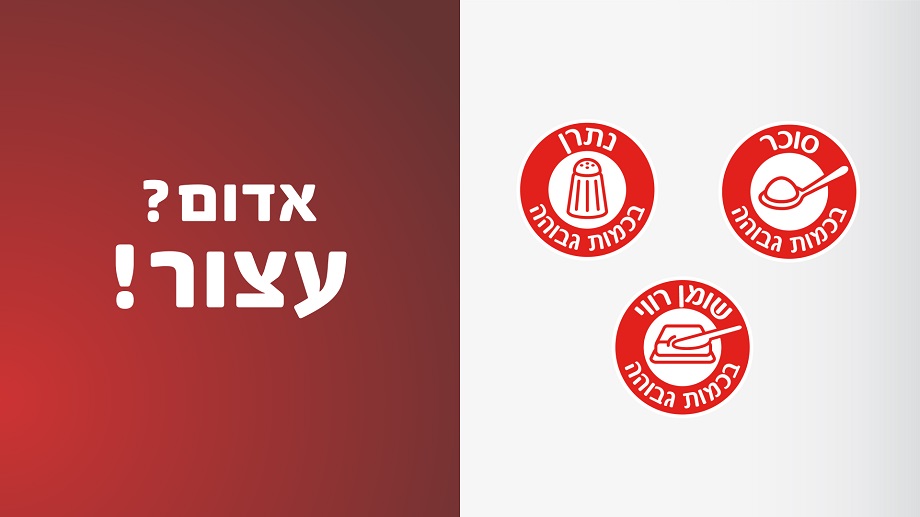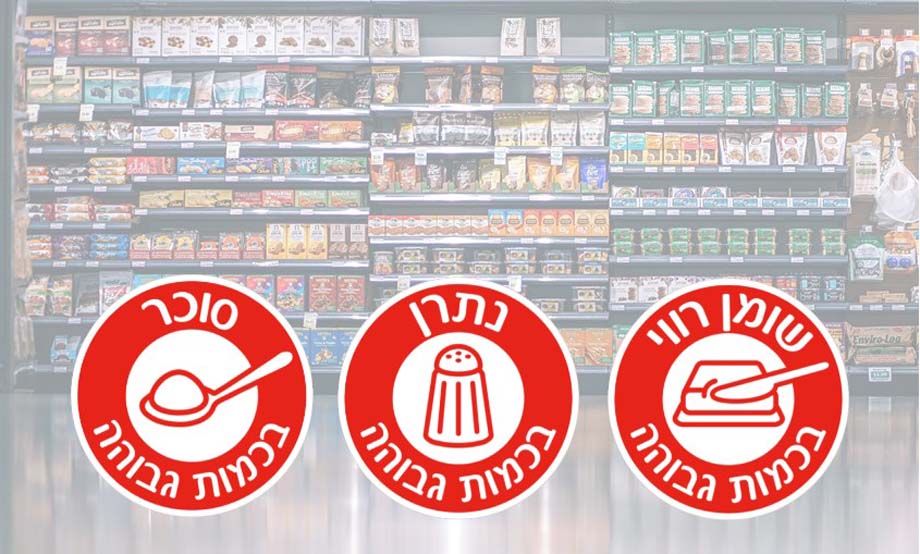
The change is under way: from January 2020, the packages of all food products containing more sugar, saturated fat and sodium (salt) than the prescribed threshold are marked with red symbols. This is a groundbreaking move by the Ministry of Health as part of its activities within the national EfshariBari program, which was accepted as part of the recommendations of the Ministry's Regulatory Board and approved by the Knesset in December 2017.
How can food labeling help us consume healthier food?
The purpose of the new regulations is to make information clearly available to us, consumers, about the nutritional value of packaged foods by means of symbols that indicate that the food contains a high amount of sodium, sugars or saturated fatty acids, to allow an informed choice of healthier foods. The need for clear and accessible information is on the rise since more food products carry marketing messages that present them as "healthy" while in fact they contain such amounts of sugar, saturated fat and sodium so that they can be categorized as harmful food.
Furthermore, this labeling helps us make quick decisions at points of sale: the grocery store, the beachfront kiosk, the supermarket, wherever we need to decide what to buy and what the less harmful options are.

Red symbol? Stop!
High level of saturates (saturated fats); high level of sodium; high level of sugar
Why symbols with graphics and colors were chosen and not just text
Studies of similar projects around the world have found that simple graphics, not just texts, are accessible and understandable to young children who have not learned to read. Additionally, this labeling also facilitates decision-making for adults who do not always have the time to read all the information on each and every package, and certainly not while standing in the aisle or at checkout. Additionally, this issue was brought up in the public discussions of the Ministry of Health's Regulatory Committee, in which various public representatives expressed the need for a general move towards clear and informative labeling on the packages, which will allow consumers to make quick – and informed – purchase decisions.
Is it forbidden to consume food products labeled with the Red symbol?
No. The goal of the red symbol is to promote better-informed consumption, encourage consumers to choose healthier alternatives in the same category or change, if possible, our eating habits. Products labeled with the red symbol are usually those that contain large quantities of sugar, saturated fat and sodium, and therefore we should consume them as sparingly as possible.
The red symbol for harmful food products allows us to decide that red symbol products stop being part of our family shopping list, or our shopping list for parties and birthdays in schools and kindergartens.
The food industry has changed many products to avoid the red symbol. Is this problematic?
On the contrary. In the adjustment period given to the food industry to reorganize ahead of the implementation of the reform, a significant portion of manufacturers were not satisfied with merely labeling their existing products, but rather initiated re-formulation processes for their products, that is to say, changing the recipes of their existing products to contain smaller quantities of sugar, saturated fat and salt, as well as developing new products that meet the reform's requirements. The result is that there are smaller quantities of saturated fat, sodium and sugar than before, which is good news, and part of the reform's goals.
Does the food labeling also refer to naturally occurring sugar in the food?
Yes. As a general rule, high quantities of sugar are harmful, whether this is naturally occurring sugar or refined sugar added in the manufacturing process. Therefore, the calculation of the total sugar quantity in the product that determines whether or not a product will carry the red symbol (as well as the number of teaspoons of sugar, on the back of the product) takes into account both naturally occurring sugar and added sugar (of course, in unprocessed products that only contain a single ingredient, such as fresh fruits, labeling is not required).
Why does the red symbol only refer to saturated fat and not all types of fat?
Many studies, including the latest recommendations by the American Heart Association, show that high consumption of saturated fat increases the risk for cardiovascular diseases. Therefore, we should be careful with the amounts of saturated fat we consume. There are other fats that are actually included in the Ministry of Health's recommendations for a health and balanced nutrition and will be marked with the green symbol.
Which products will have to bear a red symbol?
The regulations distinguish between solid and liquid foods, as well as two "stages" in the process where the threshold values will vary:
First stage - January 2020:
| Labeled ingredient | Quantity in 100 g solid food | Quantity in 100 ml liquid food |
|---|---|---|
| Sodium | 500 mg | 400 mg |
| Total sugars | 13.5 g | 5 g |
| Total saturated fatty acids | 5 g | 3 g |
Second stage - January 2021:
| Labeled ingredient | Quantity in 100 g solid food | Quantity in 100 ml liquid food |
|---|---|---|
| Sodium | 400 mg | 300 mg |
| Total sugars | 10 g | 5 g |
| Total saturated fatty acids | 4 g | 3 g |
Keep in mind that the fact a certain food does not qualify for a red symbol does not necessarily mean it is healthy, recommended or approved by the Ministry of Health.
High level of saturates (saturated fats); high level of sodium; high level of sugar
Printable red labeling poster in Hebrew and Arabic
The District Health Office – Jerusalem District, has designed and produced a unique poster that expresses the red symbol and explains it in simple terms, in order to help consumers make healthier choices. The poster can be circulated in various settings such as: Tipat Halav clinics, HMOs, hospitals, workplaces, the education system, food retailers and more.
Red symbol poster – Hebrew
Red symbol poster – Arabic
What kinds of foods will be marked with the green symbol?
The green symbol is intended to help consumers understand which foods are better for them as part of a healthy and balanced nutrition. The green symbol means that these are "raw foods", namely: Foods that are as close as possible to their original form or with minimal processing. The varied list of "green" foods includes dairy products and dairy substitutes (milk, yogurt, cheeses, tofu, soy drink), certain vegetable oils, seeds and nuts, whole grains, legumes, raw tahini and tahini salad, fish, eggs, packaged chicken, fruit and vegetables. Particular requirements have been determined for each of these food groups to render them eligible for the green symbol – should they meet these requirements.
Further information on the green symbol
What about food products that are marked with neither the red nor the green symbol?
The fact that a certain product has not been marked with the red symbol certainly does not indicate that this is a recommended product or that it should be part of a healthy and balanced diet. The absence of the red symbol only means that the sodium, saturated fat and sugar values in this product are lower than the red symbol threshold.
Further reading
Full version of the Public Health Protection Regulations, Nutrition Labeling 5778-2017 (Hebrew)
Harmful food symbols on the Ministry of Health website (Hebrew)
Guidelines for Buying Safe Food, Ministry of Health website (Hebrew)




